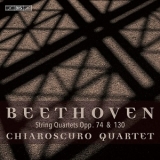Ein mittleres und ein spätes Quartett von Beethoven bietet das Chiaroscuro Quartet auf seinem jüngsten Album an. Wiederum mit bestechender Technik, sowohl beim Quartett wie auch bei der Aufnahme, lassen die vier Musiker erneut eine intensive und in alle Winkel und Ecken schauende Durchleuchtung der zwei eingespielten Werke erleben.
Welches Bild die Musik von Beethoven vermitteln wollte oder welches wir heute hören (wollen), ist Quell vieler Überlegungen. Die Mitglieder des Chiaroscuro Quartets haben sich auf eine zwar von packendem Zugriff gekennzeichnete und trotzdem auch sehr entspannt wirkende Sicht zu Eigen gemacht.
Nun bietet gerade das Es-Dur, das als eines der lyrischsten Quartette aus Beethovens Feder gilt, an, sich den Meister in milderem Licht anzuhören. Beispielsweise im Presto – Più presto quasi prestissimo lassen sie erneut aufblitzen, dass Anforderungen an die Spielausführung für sie ohne Bedeutung sind, sie können es eben, auch im prestissimo. Und es liegt sicherlich nicht nur daran, sondern war auch Absicht, dass sie die Gestaltung schwungvoll ausleben, aber ohne jegliche Ecken und Kanten, Spitzen und Scharten.
Das B-Dur Quartett ist hier in der Fassung von 1826 zu hören, also der abgeänderten Version mit neuem Schlusssatz statt der ursprünglich von Beethoven gewählten Fuge. Auch in diesem Gattungsbeitrag zeigen sich die Musiker des Chiaroscuro Quartet von der sanften Seite. Gleichzeitig gelingt es ihnen, ein über die gesamte Dauer, hier immerhin gut 40 Minuten, die Spannung haltendes Gesamtgefüge zu intonieren, so dass zu keinem Zeitpunkt Langeweile aufkommt. Die Konzentration beim Zuhörer wird eher durch leise Momente, man möchte fast sagen, Einwürfchen hochgehalten, die man ohne interessiertes Zuhörer nicht wahrnehmen würde. Bereits im ersten Satz wird Kammermusik durch dezidiert akribische und attraktive Feinarbeit und nicht durch auftrumpfende Lautstärke gezeigt.
Man mag ein solch weicher gezeichnetes Bild von Beethovens Musik ablehnen, aber es bietet einen neuen Hörzugang, der durchaus seinen großen Charme hat.
A middle and a late quartet are offered by the Chiaroscuro Quartet on their latest album of works by Beethoven. Again with captivating technique, both in the quartet as well as in the recording, the four musicians again offer an intense and in all nooks and crannies looking through the two recorded works.
Which image Beethoven’s music wanted to convey or which one we (want to) hear today is the source of many considerations. The members of the Chiaroscuro Quartet have adopted a view characterized by gripping access, yet also very relaxed. Now the E-flat major in particular, considered one of the most lyrical quartets from Beethoven’s pen, offers a chance to listen to the master in a milder light. In the Presto – Più presto quasi prestissimo, for example, they once again show that demands on the performance are of no importance to them; they just can do it, even in the prestissimo. And it is certainly not only because of this, but was also the intention, that they live out the arrangement with verve, but without any rough edges, peaks and nicks.
The B-flat major quartet is heard here in the version of 1826, i.e. the modified version with a new final movement instead of the fugue originally chosen by Beethoven. In this contribution to the genre, too, the musicians of the Chiaroscuro Quartet show themselves from the gentle side. At the same time, they succeed in intoning an overall structure that maintains the tension over the entire duration, here a good 40 minutes, so that boredom does not arise at any time. The listener’s concentration is rather kept high by quiet moments which one would not notice without interested listening. Already in the first movement chamber music is shown through decidedly meticulous and attractive fine work and not through showy volume.
One may reject such a softer drawn picture of Beethoven’s music, but it offers a new listening approach that definitely has its great charm.
























